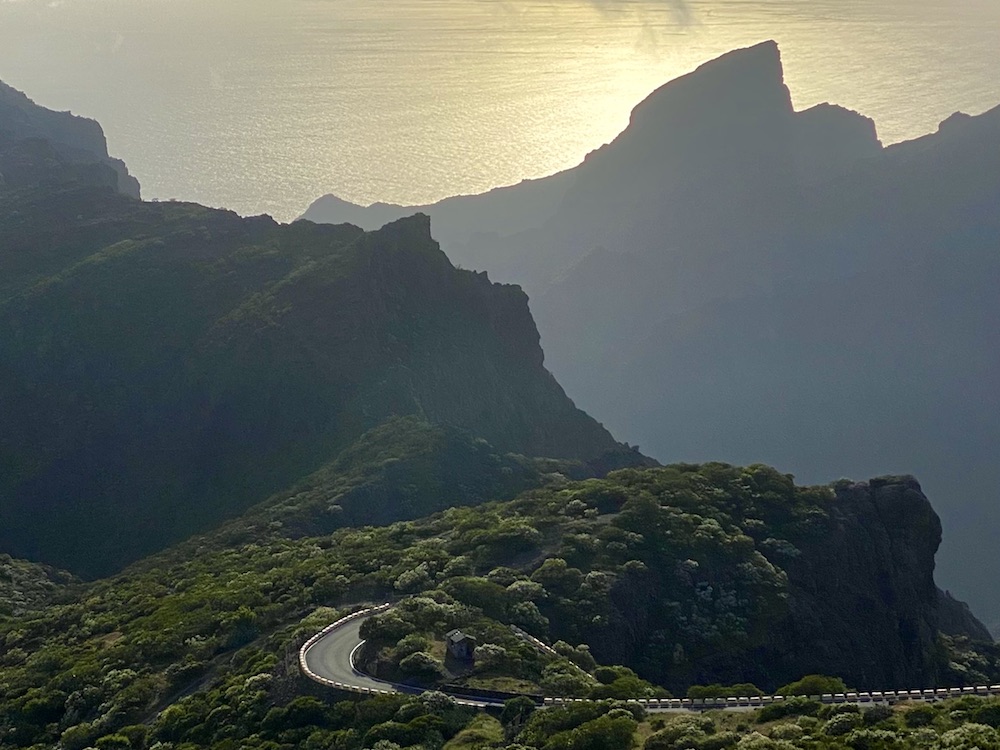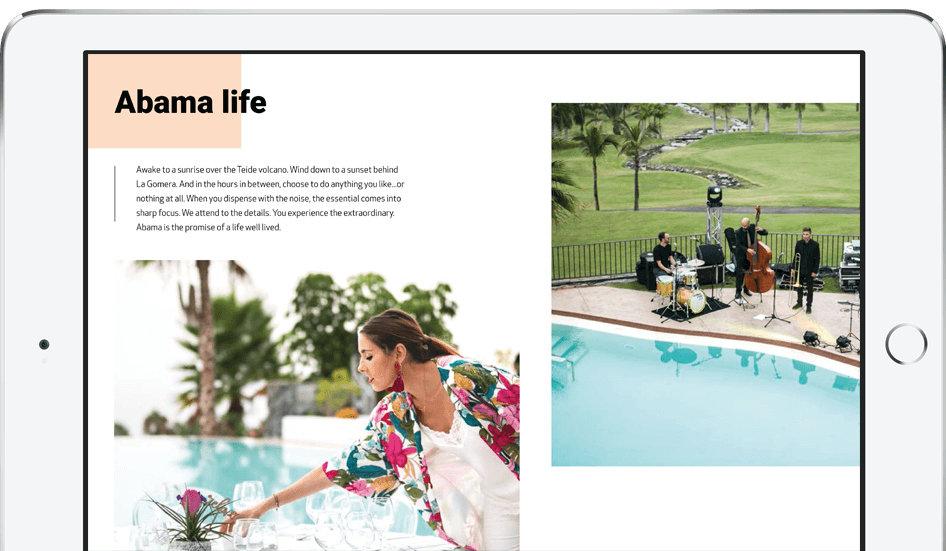
Intimately linked to physical and mental health, and closely conditioned by the environment, wellness is a state of fulfillment that extends beyond the individual. The degree to which each human being finds inner balance defines her ability to relate to the people around her and her surroundings. There are many techniques and methods that have been honed over millennia with the aim of illuminating paths to self-knowledge and inner harmony, and thanks to the global interconnection of our modern world, we have more access to knowledge than ever. We can deepen our understanding of ancient techniques and combine it with the scientific knowledge that moves us towards a better quality of life.
Here at Abama, we are lucky to have many means at our disposal to pursue greater wellness, beginning with the peaceful natural environment that surrounds us. Tenerife is also a place abundant in flora that are the key ingredients in natural therapies; a font of organic local food; and the location of cutting-edge preventative medicine centers. In these privileged surroundings, our owners and guests can take a wellness retreat, and have access to expert instruction in yoga, Ayurvedic philosophy, and sport during a Wellness Weekend. These practices are designed to balance the body and mind and generate a harmony that enriches daily life.
Green spaces for a healthy lifestyle
The deep neurobiological connection of the human being with nature has been analyzed exhaustively, and the unanimous conclusion is that direct contact with a natural environment reduces stress and enhances creativity. A study led by Terry Hartig, professor of psychology at the University of Uppsala (Sweden) demonstrated, for example, that after a 40-minute outdoor excursion, intellectual abilities sharpen.
Forests, beaches, meadows, hills: whatever setting you choose, breathing fresh air and taking in the landscape generates a therapeutic effect. Muscles relax, breathing deepens, and pressure on the brain decreases.
In an urban environment, the primitive parts of our brain are on alert against danger, while in nature, there is a greater predisposition to concentration, which stimulates creativity. Several studies have shown that being in a natural environment reduces levels of cortisol (our stress hormone), and particularly noteworthy is the conclusion that people with green spaces less than 3 km from their home show less psychological distress in the face of conflicts and have fewer complaints about their health than others not so lucky. Spending at least three hours a day outdoors has also been shown to delay the onset of visual problems such as presbyopia and prevent eye strain from excess fatigue.
Tenerife, where more than half the territory is protected natural land, is an incredible oasis of far more than just beaches. Its unique microclimates have promoted the growth, over centuries, of places like Anaga Rural Park, an official Biosphere Reserve, and the ancient Laurel forests with vegetation that has been alive for more than 1,000 years. And the area surrounding the Teide volcano, the highest peak in Spain, always offers new adventures.
The power of nature
Throughout human history, the healing properties of plants have been a prized and carefully guarded body of knowledge. Active ingredients that exist naturally in herbs, flowers, stems and leaves have been used to cure ailments and calm the mind. With scientific advances, it has also been possible to verify and catalogue the chemical properties of plant extracts and determine appropriate dosages and uses. In fact, present-day pharmacology has leveraged the healing power of many natural components for the manufacture of medicines and has made scientific cases to warn against the use of other plants that can be harmful or toxic.
Thanks to this accumulated knowledge, today we are all familiar with the healing properties of, for example, aloe vera. This plant is a powerful anti-inflammatory agent, ideal for treating burns and useful against heartburn, as well as having anti-aging properties used in cosmetic treatments. Another species whose therapies have withstood the passage of time is the Drago. Like other medicinal plants found on Tenerife, its regenerative and antioxidant properties have kept it relevant even today as a natural ally for skin care and other therapeutic treatments.
Direct from the garden to the table
Since the 1800s, when French and German philosophers introduced the idea that what you eat is intimately tied to your physical and mental health, an avalanche of research has delved into the nutritional components of food and the best way to combine them to promote body-mind balance. Consuming the right percentages of proteins, fats and carbohydrates can be complicated when the market is saturated with processed food or products of unknown origin. And when you add environmental concerns to the picture, it’s clear that solutions are urgently required to reduce pollution and the chemicals we introduce into our bodies and environments.
A cornerstone of lifelong healthy habits is to seek out high-quality food, grown sustainably. This means choosing local ingredients that do not have to be transported long distances, thereby reducing unnecessary CO2 emissions. Production methods are also crucial: best are organic products and ingredients that have not been sprayed with toxic pesticides or grown with chemical fertilizers. It’s important to seek out vegetables and fresh produce grown in season, allowing the land to lie fallow as needed, and take advantage of our island’s climate to enjoy the tropical fruit that, in addition to being beautiful and delicious, are a wonderful source of vitamins, minerals and proteins with medicinal properties.
Additionally, healthy food made with fresh, locally produced ingredients can be a delight when prepared carefully. Gone are the days when nutritionists believed that salad was the healthiest alternative; today’s high-nutrition menus combine organic fruit, legumes, vegetables, healthy red and white meat, and whole grains in a wide range of options to satisfy any palate.
Yoga’s age-old balance
In an era when we all spend hours a day in front of the computer, it’s ancient practices that can best remind us of the importance of physical posture in the channeling of energy and the release of stress. Going far beyond physical exercise, though, yoga is a path to self-realization composed of eight “limbs”. Several authors describe these limbs as methods to reach a true state of Yoga or connection, but those who begin to practice without the intention of becoming teachers can at least take the essential elements of each limb and begin to incorporate them into their daily lives. In this way, yoga teaches discipline, stability, concentration, self-control, meditation, patience, coherence between thought and action, and serenity in the face of conflict.
In the practice of yoga, body alignment is achieved through different movements and stretches, but unlike other physical work, breath coordination is essential. It is the key to awareness that allows you to center your mind and body. And contrary to what many believe, flexibility is not essential for performing the exercises well. Guru Xuan Lan, of Xuan Lan Yoga, believes “anyone of any age can start practicing yoga,” as long as you do not suffer from a serious injury or illness that prevents it.
The holistic vision of Ayurvedic philosophy
The human body is not an isolated entity, and this holistic vision has driven Ayurvedic philosophy to include medical treatments, dietary guides, emotional support and physical movement for more than 5,000 years. Originally from India, Ayurveda guides disconnection from routine and stress through the five elements of Earth, Water, Fire, Air and Ether. These elements merge with the body through three humors or doshas known as vata, pitta and kapha, and physical and mental health depend on their perfect harmony.
The fundamental premise of Ayurvedic medicine is that wellness is achieved by finding a point of balance between body, mind and spirit. Natural remedies, specific nutrients, application of heat or cold at strategic points on the body, meditation techniques and other measures are part of treatments that approach health from a distinct vantage point. Nonetheless, the so-called “science of life” is not exclusive of other ancient philosophies like yoga, and it can complement Western medicine, especially for chronic diseases.
Customized routines and personal training
As individuals seek wellness, personalization is not only important, but necessary. Athletes had personal trainers at their disposal even in Ancient Greece, and throughout history, this idea of mentoring or coaching has remained at the fore of all athletic disciplines. But it was not until after World War II that the role of the trainer was popularized, thanks to the rising interest in health and exercise among the majority population of non-professionals. With the opening of gyms at affordable prices in cities all over the world, more and more people can exercise with equipment, and many choose to go a step further and hire the services of a coach or personal trainer.
Each human body is different, each person has different objectives, and everyone favors different methods of learning. The most efficient way to cut through these differences is to work with a personal trainer who can adapt their methodologies to each case. Ideally, this person can not only design Pilates, yoga, or fitness sessions that will work for their clients, but also recommend a nutritional regimen that is healthy and easy to follow. It’s the best of Eastern and Western methods, brought together in a tailored approach.
Pilates classes, when taught by a trained expert, have proven particularly useful in readaptation and rehabilitation therapies for muscle toning, a delicate issue for the elderly or for those who have lost mobility through accident or illness. In these cases, where a close bond of trust is essential, an expert who can come to your home and offer exclusive attention can make a positive difference with respect to group classes where there may not be enough time to analyze the limitations or particularities of each person in the class.
Preventive medicine in a tranquil environment
The World Health Organization (WHO) has carried out several studies on the relationship between environmental health and external factors including chemical agents, biological components and the physical characteristics of the environment in which a person moves. Pollution, which is a source of cardiovascular disease, lung disease, allergies and cancers, is a permanent red alert in the 21st century, especially when combined with the high levels of stress most people experience.
Being able to get away from the hostility of an urban environment and into a more natural environment, even for a few days, is a great opportunity to get in shape at every level. Nautical activities that mix adventure and sport, restoring massages, and master classes that combine fitness and dance are just a few options that, when offered in a unique environment, can be the starting point for a complete change in routine.
Also fundamental to health is the use of modern diagnostic tools to assess the body’s function. Most importantly, the objective is to act preventively rather than waiting for an organ to fail. CVD prevention and detection equipment, such as that offered at the Abama Bach Care center, takes cardiovascular readings with the most advanced technology in the world, and recommends programs of personalized and preventive care for each individual. These scientific advances are at the service of physical health, but also have enormous impact on emotional health, when combined with nutritional recommendations and mindfulness techniques that help achieve a healthy lifestyle through self-knowledge, detachment and self-acceptance. This is knowledge that you can continue to use when practicing healthcare at home.
The cornerstone of the Abama lifestyle, wellness is innate in every aspect of our resort. The result is a unique place where our green landscape, the silence that envelops us, the rhythm of the ocean, and the exuberance of our volcanic geography provide the ideal setting for escape from urban irritants. Wellness is about taking a conscious break, letting yourself be guided by a natural pace, savoring healthy meals, renewing your energy and, most importantly, gleaning life lessons from ancient practices that will stay with you beyond your time at Abama.







